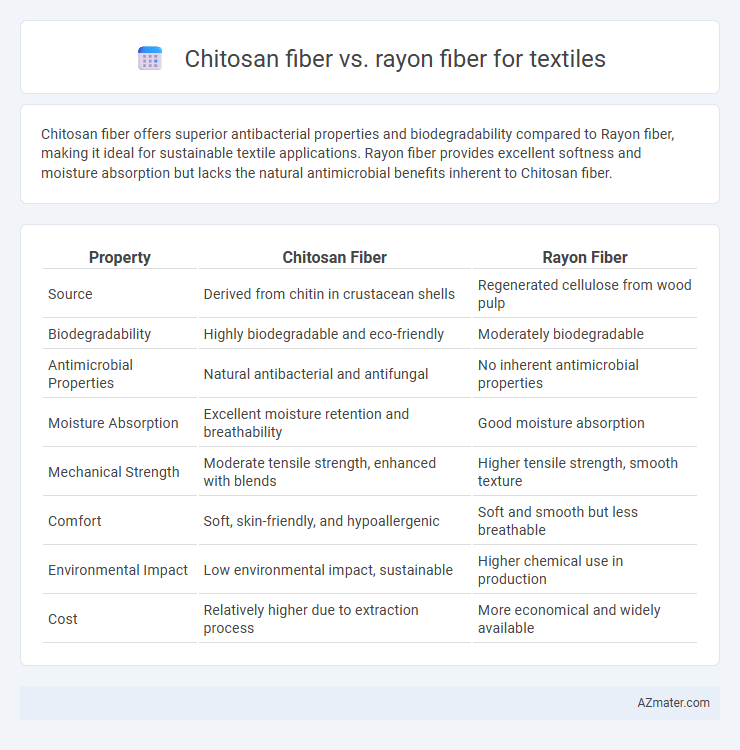Chitosan fiber offers superior antibacterial properties and biodegradability compared to Rayon fiber, making it ideal for sustainable textile applications. Rayon fiber provides excellent softness and moisture absorption but lacks the natural antimicrobial benefits inherent to Chitosan fiber.
Table of Comparison
| Property | Chitosan Fiber | Rayon Fiber |
|---|---|---|
| Source | Derived from chitin in crustacean shells | Regenerated cellulose from wood pulp |
| Biodegradability | Highly biodegradable and eco-friendly | Moderately biodegradable |
| Antimicrobial Properties | Natural antibacterial and antifungal | No inherent antimicrobial properties |
| Moisture Absorption | Excellent moisture retention and breathability | Good moisture absorption |
| Mechanical Strength | Moderate tensile strength, enhanced with blends | Higher tensile strength, smooth texture |
| Comfort | Soft, skin-friendly, and hypoallergenic | Soft and smooth but less breathable |
| Environmental Impact | Low environmental impact, sustainable | Higher chemical use in production |
| Cost | Relatively higher due to extraction process | More economical and widely available |
Introduction to Chitosan and Rayon Fibers
Chitosan fiber, derived from chitin found in crustacean shells, offers biodegradable, antimicrobial, and eco-friendly properties, making it ideal for sustainable textile applications. Rayon fiber, a semi-synthetic fiber regenerated from cellulose sources such as wood pulp, is known for its softness, breathability, and versatility in creating various fabric textures. Both fibers serve distinct roles in the textile industry, with chitosan fibers emphasizing bioactivity and sustainability, while rayon fibers prioritize comfort and affordability.
Raw Material Sources and Sustainability
Chitosan fiber is derived from chitin, primarily sourced from shellfish exoskeletons, offering a biodegradable and renewable alternative with strong antimicrobial properties. Rayon fiber is produced from regenerated cellulose extracted from wood pulp, raising concerns regarding deforestation and chemical-intensive processing. The sustainability advantage of chitosan fiber lies in its utilization of seafood industry waste, contributing to circular economy practices, whereas rayon's environmental impact depends heavily on sustainable forestry management and eco-friendly manufacturing technologies.
Fiber Production Processes
Chitosan fiber production involves extracting chitosan from crustacean shells, dissolving it in an acidic solution, and spinning it into fibers using wet spinning, emphasizing biodegradability and antibacterial properties. Rayon fiber production starts with cellulose from wood pulp, chemically treated with alkali and carbon disulfide to create viscose solution, followed by wet spinning to form fibers known for softness and breathability. Chitosan fibers require more complex biologically-derived processing, whereas rayon fibers depend on extensive chemical treatments and large-scale industrial methods.
Environmental Impact Comparison
Chitosan fiber, derived from crustacean shells, offers biodegradability and antimicrobial properties, significantly reducing environmental pollution compared to synthetic-based rayon fibers that rely heavily on chemical processing and non-renewable resources. Rayon production involves extensive use of toxic chemicals like carbon disulfide and sodium hydroxide, leading to hazardous waste and water contamination, whereas chitosan fiber production minimizes chemical use and enhances waste valorization. Chitosan's renewable source and superior biodegradability contribute to lower carbon footprints and less ecological harm, positioning it as a sustainable alternative in textile manufacturing.
Mechanical Properties of Chitosan vs Rayon
Chitosan fiber exhibits superior tensile strength and elasticity compared to rayon fiber, enhancing durability and flexibility in textile applications. The biodegradability and antimicrobial properties of chitosan contribute to improved fabric longevity and hygiene, whereas rayon tends to have lower mechanical resilience and moisture management. Chitosan's excellent fiber strength and abrasion resistance make it a sustainable alternative for high-performance textile products.
Biodegradability and End-of-Life Scenarios
Chitosan fiber exhibits superior biodegradability compared to rayon fiber, breaking down more rapidly in natural environments due to its natural polysaccharide composition derived from chitin. Rayon, although semi-synthetic and cellulose-based, often undergoes chemical processing that slows its degradation and complicates end-of-life scenarios, frequently resulting in landfill accumulation or incineration. The sustainable disposal advantage of chitosan fiber supports eco-friendly textile applications, promoting circular economy practices through more efficient composting and reduced environmental impact.
Comfort and Wearability in Textiles
Chitosan fiber offers superior moisture absorption and antibacterial properties, enhancing comfort by keeping the skin dry and reducing odor in textiles. Rayon fiber provides excellent softness and breathability, but lacks the inherent antimicrobial benefits found in chitosan. Wearability in textiles is improved with chitosan fiber due to its natural biocompatibility and durability, making it ideal for sensitive or activewear applications.
Antimicrobial and Functional Properties
Chitosan fiber exhibits superior antimicrobial properties due to its natural biopolymer structure that inhibits bacterial growth, making it highly effective in hygienic textiles. In contrast, rayon fiber, derived from cellulose, lacks inherent antimicrobial activity but offers excellent moisture absorption and softness. Functional properties of chitosan fiber include biodegradability and biocompatibility, positioning it as an eco-friendly alternative to rayon with added health benefits in medical and sportswear applications.
Cost and Commercial Availability
Chitosan fiber, derived from chitosan biopolymer, generally incurs higher production costs due to its complex extraction and processing methods compared to rayon fiber, which is mass-produced from cellulose and benefits from established manufacturing infrastructure. Rayon fiber dominates the textile market with widespread commercial availability and lower price points, making it a cost-effective choice for large-scale textile applications. Despite its higher cost and limited availability, chitosan fiber offers added value through antimicrobial properties and biodegradability, appealing to niche markets focused on sustainability and functional textiles.
Future Trends in Textile Fiber Innovation
Chitosan fiber, derived from crustacean shells, offers biodegradable, antimicrobial, and moisture-regulating properties, positioning it as a sustainable alternative to traditional rayon fibers in textile innovation. Advances in bio-based fiber technology emphasize eco-friendly, functional fabrics that reduce environmental impact while enhancing wearer comfort and hygiene. The future textile industry is expected to prioritize chitosan fiber development to meet growing consumer demand for sustainable, high-performance apparel materials.

Infographic: Chitosan fiber vs Rayon fiber for Textile
 azmater.com
azmater.com